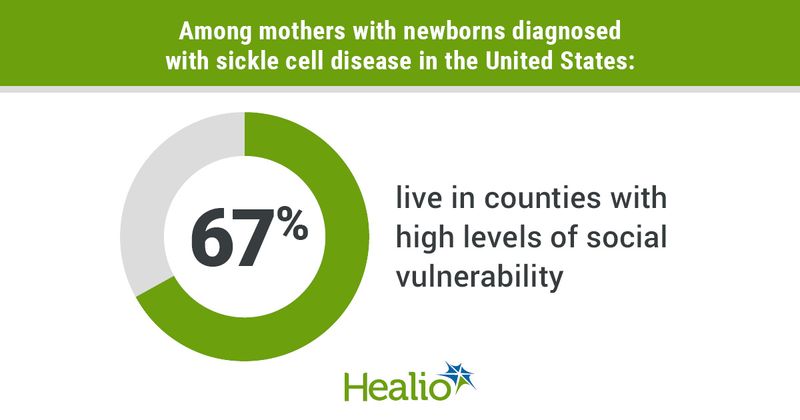Study: Most US newborns with sickle cell disease are born in vulnerable areas
Key takeaways:
- Birth prevalence of sickle cell disease is one in 2,070 overall and one in 350 for non-Hispanic Black newborns.
- Most mothers of newborns with sickle cell disease live in areas with high social vulnerability.
About two-thirds of newborns with sickle cell disease in the United States are born to mothers who live in counties with high or very high levels of social vulnerability, according to research findings published in MMWR.
An inherited blood disorder, sickle cell disease (SCD) is associated with complex health needs, reduced life expectancy and high cost of care, and results from mutations in the hemoglobin subunit beta (HBB) gene, the authors of the new report noted.

“The protective association between variants in HBB and severe Plasmodium falciparum malaria results in a higher prevalence of HBB mutations in geographic areas with high malaria prevalences,” they wrote. “The combination of this protective effect and the historical trans-Atlantic slave trade has resulted in SCD primarily affecting Black or African American (Black) persons in the U.S., leading to exacerbation of high disease-associated morbidity in groups affected by structural racism and health inequities.”
CDC-funded investigators analyzed state newborn screening data collected from 2016 to 2020 in 11 states to assess SCD prevalence at birth and characterize newborns’ social vulnerability level using factors such socioeconomic status, housing type and transportation.
According to the records of 3,305 SCD-affected newborns from 2016 to 2020, 67% were born to mothers who live in U.S. counties with high or very high levels of social vulnerability. The SCD birth prevalence was one in every 2,070 births overall, and one in every 350 birth among non-Hispanic Black newborns.
Around half of mothers of newborns with SCD resided in areas with high or very high socioeconomic vulnerability and household characteristic vulnerability.
“These findings align with previously reported estimates of SCD affecting one in every 2,024 newborns overall and one in every 365 non-Hispanic Black newborns,” the authors wrote.
They said the findings can inform community-based efforts to improve access to quality care for newborns and children.
“Implementation of tailored interventions, such as increasing access to transportation, improving housing, and advancing equity in high vulnerability areas, could improve health outcomes for children with SCD,” they wrote.
